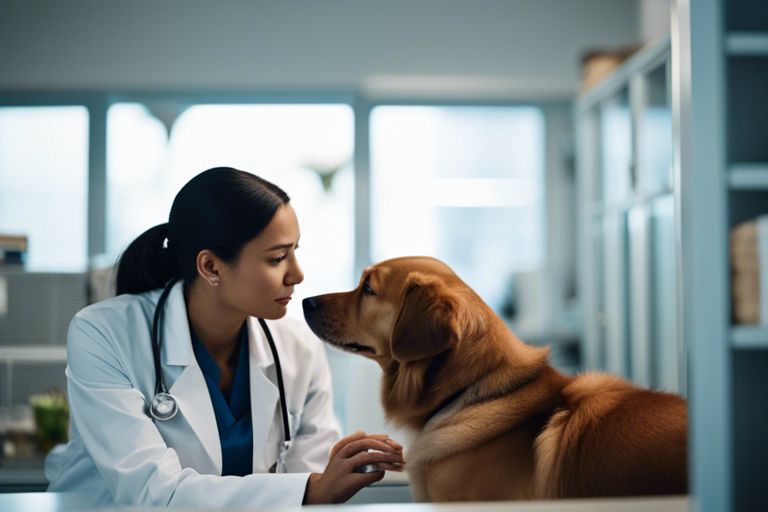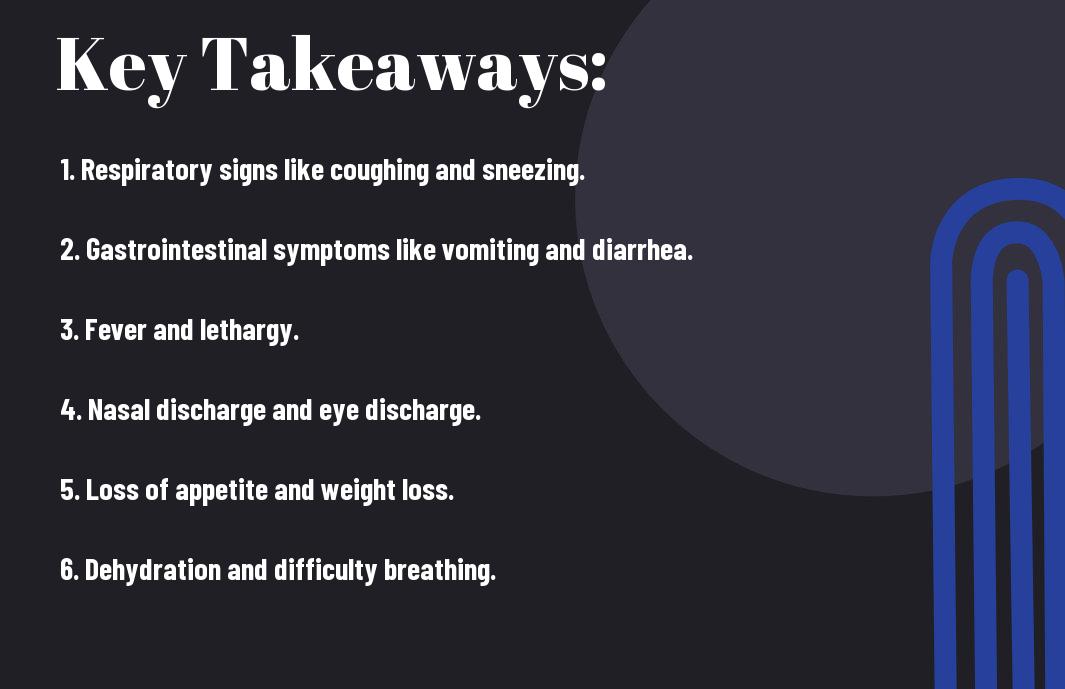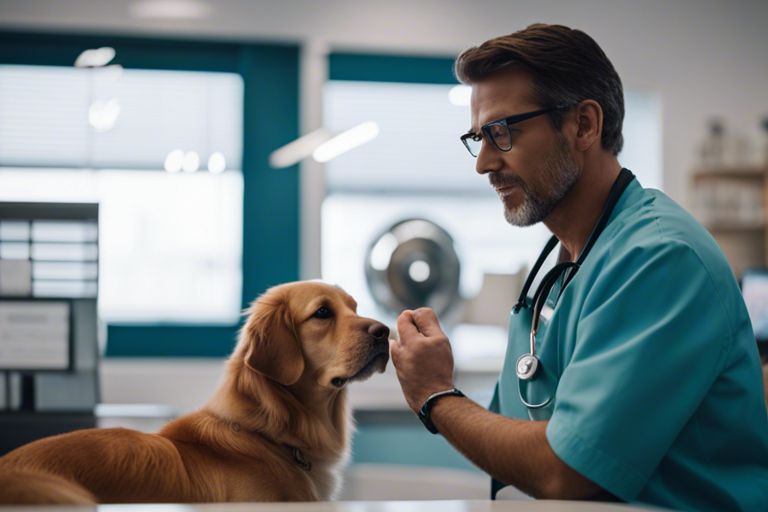Symptoms of the new dog virus can be subtle at first, but it’s crucial to be vigilant. Watch for signs like lethargy, loss of appetite, coughing, and nasal discharge. You may notice your canine companion experiencing vomiting, diarrhea, or even difficulty breathing. If you observe any of these symptoms in your furry friend, seek veterinary care immediately to ensure a speedy recovery. Do not forget, early detection is key in combating this emerging threat to our beloved pets.
Key Takeaways:
- Fever and cough: Dogs infected with the new virus may experience a fever and persistent cough as initial symptoms.
- Loss of appetite: A noticeable decrease in appetite or refusal to eat is another common symptom seen in infected dogs.
- Difficulty breathing: As the virus progresses, dogs may exhibit difficulty breathing, which can be a serious indication of the severity of the infection.
Identifying the Virus
What is the new dog virus?
While the symptoms of the new dog virus can be alarming, it is important to understand what this virus actually is. The new dog virus, also known as Canine Respiratory Coronavirus (CRCoV), is a highly contagious respiratory virus that affects dogs. It can cause symptoms similar to the common cold in humans, such as coughing, sneezing, and nasal discharge. However, in severe cases, it can lead to pneumonia and other serious respiratory issues in dogs.
How is it transmitted?
Any close contact with an infected dog, such as being in the same living space or playing together, can increase the risk of transmission of the new dog virus. The virus can spread through respiratory secretions, such as coughing or sneezing, as well as through contact with contaminated surfaces like dog bowls or toys.
Plus, the virus can also spread indirectly through contact with items that have been contaminated with the virus, such as clothing or hands that have touched an infected dog. It is crucial to practice good hygiene measures, such as washing your hands thoroughly after handling dogs or their belongings, to help prevent the spread of the virus.
Common Symptoms
One of the most common symptoms of the new dog virus are respiratory issues. Dogs infected with the virus may exhibit symptoms such as coughing, sneezing, nasal discharge, and difficulty breathing. If you notice your dog having trouble with their breathing or showing any signs of respiratory distress, it is necessary to seek veterinary care as soon as possible.
Respiratory issues
One more symptom that may appear is a persistent cough. If you notice your dog coughing frequently or if the cough seems to be getting worse over time, it could be a sign of the new dog virus. Other respiratory issues may include wheezing, labored breathing, and nasal discharge.
Digestive problems
With digestive problems, dogs infected with the new virus may experience symptoms such as vomiting, diarrhea, lack of appetite, and abdominal pain. These digestive issues can lead to dehydration and weight loss if not addressed promptly. If you observe any of these symptoms in your dog, it is crucial to consult with your veterinarian to determine the best course of action for treatment.
Problems with the digestive system can range from mild to severe, depending on the severity of the virus and the overall health of the dog. Monitoring your dog’s eating and bathroom habits can help you detect any digestive problems early on and seek appropriate medical attention.
Skin irritations
Skin irritations are another common symptom of the new dog virus. Dogs may develop rashes, itching, redness, or sores on their skin. These skin issues can be uncomfortable for your dog and may indicate an underlying infection. If you notice any changes in your dog’s skin condition, it is important to consult with your veterinarian for proper diagnosis and treatment.
This can be distressing for both you and your furry friend, as skin irritations can cause discomfort and may lead to further complications if left untreated. Your veterinarian can recommend appropriate medications or treatments to help alleviate your dog’s skin problems and address the underlying virus.
Advanced Symptoms
Not all dogs infected with the new dog virus will exhibit advanced symptoms immediately. However, it’s crucial to be aware of these signs as they can indicate a more severe stage of the illness. For more information on the progression of the disease, you can refer to the article on Mystery Dog Illness 2023: Symptoms and Prevention Tips.
Seizures and Tremors
To further complicate matters, advanced stages of the new dog virus may lead to seizures and tremors in your furry companion. These neurological symptoms can be distressing to witness and may require immediate veterinary attention.
| Seizures | Tremors |
|---|---|
| Seizures can manifest as uncontrolled shaking, loss of consciousness, or rhythmic movements. | Tremors are involuntary muscle contractions that may affect a specific body part or the entire body. |
Vision Impairment
impairment of vision in dogs with the new virus is a concerning sign that the infection may have reached a critical stage. Your dog may experience blurriness, inability to focus, or even complete loss of vision. This can greatly affect their quality of life and necessitate immediate medical intervention.
Seizures and tremors, along with vision impairment, should not be taken lightly, as they indicate a serious progression of the new dog virus.
Behavioral Changes
Any noticeable changes in your dog’s behavior, such as increased aggression, confusion, or disorientation, can be signs of advanced infection. These behavioral shifts may be linked to the virus affecting the brain and nervous system. It’s crucial to monitor your pet’s behavior closely and seek veterinary care if you observe such changes.
The advanced symptoms of the new dog virus require prompt intervention and specialized care to give your beloved canine companion the best chance of recovery.
High-Risk Groups
Puppies and senior dogs
With their developing or weakened immune systems, puppies and senior dogs are particularly vulnerable to the new dog virus. Symptoms may manifest more severely in these age groups, leading to a higher risk of complications. It’s crucial to monitor their health closely and seek veterinary care promptly if you notice any concerning signs.
Dogs with compromised immune systems
An immunocompromised dog, such as one undergoing chemotherapy or with a chronic illness, is at a heightened risk of contracting and suffering from the new virus. A weakened immune system makes it harder for the body to fight off infections, making these dogs more susceptible to serious complications. Ensuring a clean and stress-free environment is crucial to protect these dogs from potential exposure to the virus.
Dogs with compromised immune systems may exhibit more severe symptoms of the new virus and may require specialized care. It’s important to work closely with your veterinarian to establish a care plan tailored to your dog’s specific needs and monitor them diligently for any changes in their health.
Dogs with pre-existing conditions
Any dog with pre-existing health conditions, such as diabetes, heart disease, or respiratory issues, falls into the high-risk category for the new dog virus. These underlying conditions can weaken the dog’s immune system and make them more vulnerable to infections. It’s crucial to manage these conditions carefully and be vigilant for any signs of illness.
Compromised by their pre-existing conditions, these dogs may experience more severe symptoms if they contract the virus. Regular veterinary check-ups and adherence to treatment plans are crucial to maintain their health and minimize the risk of complications from the new virus.
Diagnosis and Testing
Once again, when it comes to diagnosing the new dog virus, laboratory tests play a crucial role in confirming the presence of the virus in your furry friend.
Laboratory tests
Testing will typically involve analyzing blood, urine, and fecal samples to detect the virus. These tests can help veterinarians determine the severity of the infection and tailor a treatment plan specifically for your dog.
Physical examinations
An important part of the diagnostic process is conducting physical examinations on your dog. Veterinarians will look for specific symptoms such as lethargy, coughing, and gastrointestinal issues that are indicative of the new dog virus.
With the combination of laboratory tests and physical examinations, veterinarians can accurately diagnose the new dog virus and provide appropriate care for your precious pet.
Differential diagnosis
One challenge in diagnosing the new dog virus is differentiating it from other common canine illnesses such as kennel cough or parvovirus. Veterinarians may need to perform additional tests to rule out these other conditions.
Treatment and Management
Antiviral medication
To treat the new dog virus, antiviral medications may be prescribed by your veterinarian. These medications are designed to target the virus specifically, helping to reduce viral replication and alleviate symptoms. It is important to administer these medications as directed by your vet to ensure the best outcome for your furry friend.
Supportive care
The key to managing the new dog virus is providing supportive care to your pet. This includes ensuring they are well-hydrated, comfortable, and have a quiet place to rest. It’s crucial to monitor your dog’s symptoms closely and report any changes to your veterinarian.
Plus, your veterinarian may recommend additional supportive care measures such as offering bland, easily digestible food to keep your dog nourished and providing any necessary medications to address specific symptoms like diarrhea or fever.
Preventative measures
To manage the new dog virus, preventative measures are crucial. Make sure your dog is up-to-date on all vaccinations to protect against known viruses and diseases. Additionally, practice good hygiene by washing your hands after handling your dog and cleaning their living area regularly. Avoid contact with sick animals and consult your veterinarian if you have any concerns about your pet’s health.
Another important aspect of preventative measures is keeping your dog away from areas where the virus may be present, such as dog parks or boarding facilities with reported cases. By being vigilant and proactive, you can help prevent the spread of the new dog virus and protect your furry companion.
Prevention and Control
Vaccination
Control the spread of the new dog virus by ensuring your furry friend is up-to-date on all vaccinations. Vaccines play a crucial role in protecting your dog from various diseases, including the new virus. Consult your veterinarian to schedule regular vaccination appointments and stay informed about any new vaccine developments.
Hygiene practices
Practices such as regular handwashing after handling dogs and disinfecting commonly used surfaces can help prevent the spread of the virus. Additionally, ensure your dog’s living area is clean and well-maintained to reduce the risk of contamination.
Good hygiene practices not only protect your dog but also prevent the potential transmission of the virus to other animals or humans. By incorporating simple hygiene measures into your routine, you can create a safer environment for your furry companion and those around you.
Quarantine protocols
For effective control of the new dog virus, it is crucial to follow quarantine protocols if your dog shows symptoms or has been in contact with an infected animal. Quarantine helps prevent the spread of the virus to other pets in your household or community.
For instance, isolate your dog in a separate area with limited interactions until you can consult with your veterinarian or health authorities. By adhering to quarantine guidelines, you not only protect your own pet but also contribute to public health efforts in containing the virus.
Conclusion
The symptoms of the new dog virus are crucial to be aware of as a responsible pet owner. By recognizing signs such as coughing, sneezing, fever, lethargy, and difficulty breathing, you can promptly seek veterinary care for your beloved furry friend. Remember that early detection and treatment are key in ensuring the best possible outcome for your pet’s health. Stay vigilant, observe your dog closely, and seek medical attention if you notice any concerning symptoms. Your furry companion relies on you to keep them safe and healthy.
FAQ
Q: What are the symptoms of the new dog virus?
A: The symptoms of the new dog virus may include lethargy, loss of appetite, vomiting, diarrhea, coughing, and difficulty breathing.
Q: How is the new dog virus transmitted?
A: The new dog virus is primarily transmitted through close contact with infected dogs, as well as through contaminated objects and environments.
Q: Can dogs of all ages be affected by the new virus?
A: Yes, dogs of all ages are susceptible to the new dog virus, but puppies, older dogs, and dogs with weakened immune systems are at a higher risk of developing severe symptoms.
Q: Are there any preventive measures to protect dogs from the new virus?
A: To protect dogs from the new virus, it is important to ensure they are up to date on vaccinations, practice good hygiene, avoid contact with sick dogs, and keep their environment clean.
Q: Is there a treatment available for the new dog virus?
A: Treatment for the new dog virus focuses on supportive care to manage symptoms, such as fluids to prevent dehydration, medications to control vomiting and diarrhea, and in severe cases, hospitalization may be necessary.
Are strawberries toxic for dogs
Your Dog’s Allergies: Expert Advice
Demystifying Anal Gland Issues in Dogs: Your Comprehensive Guide from the American Kennel Club




